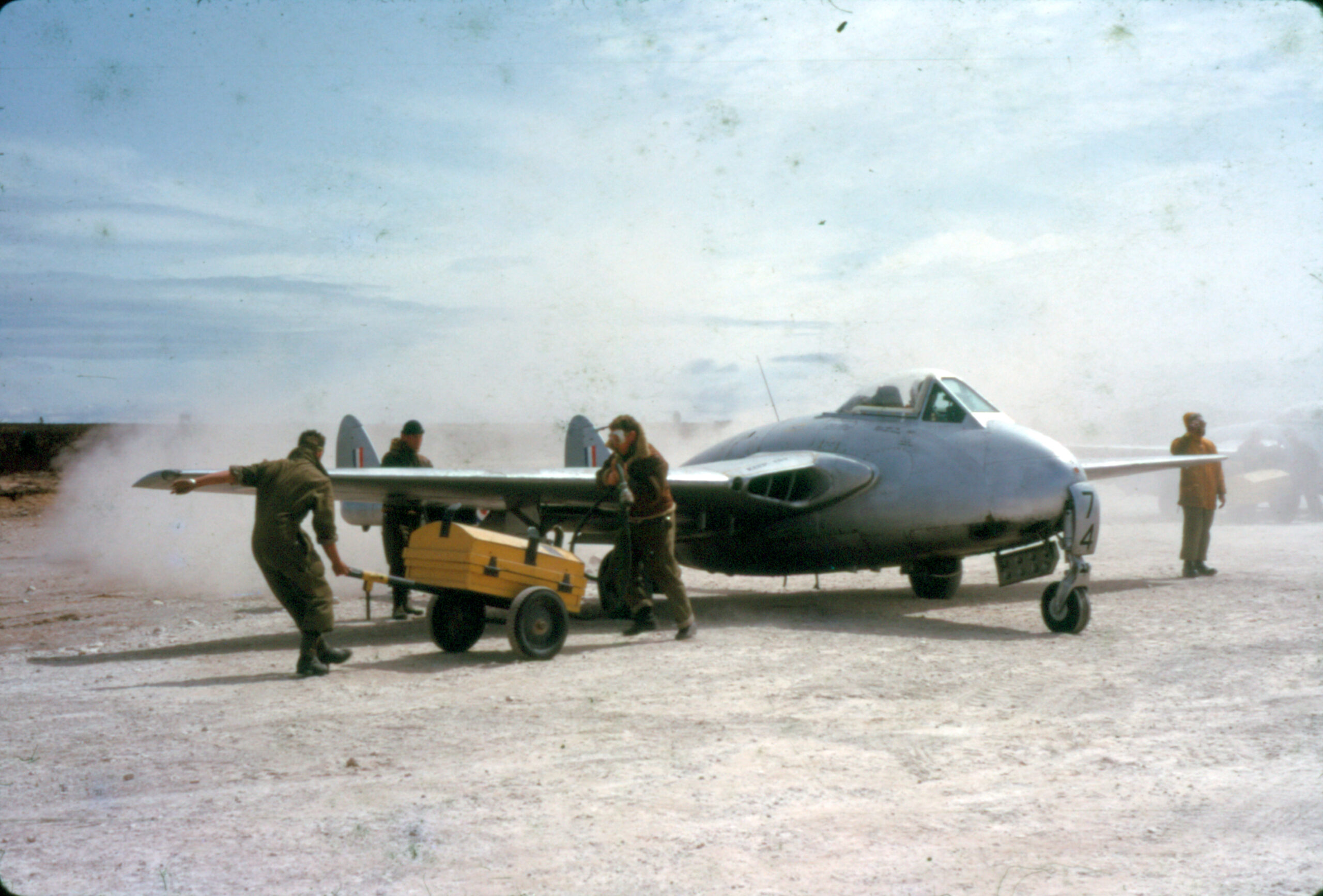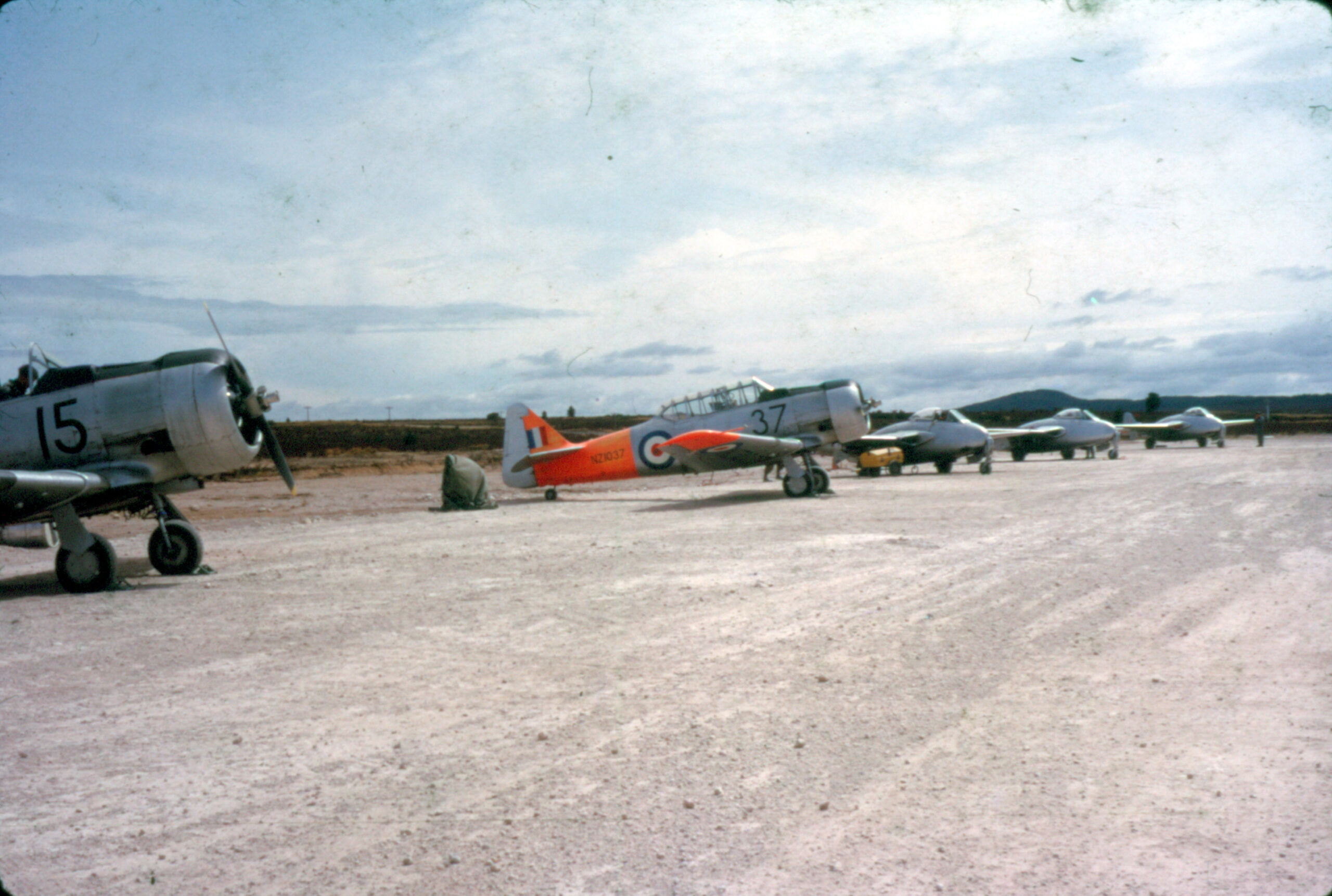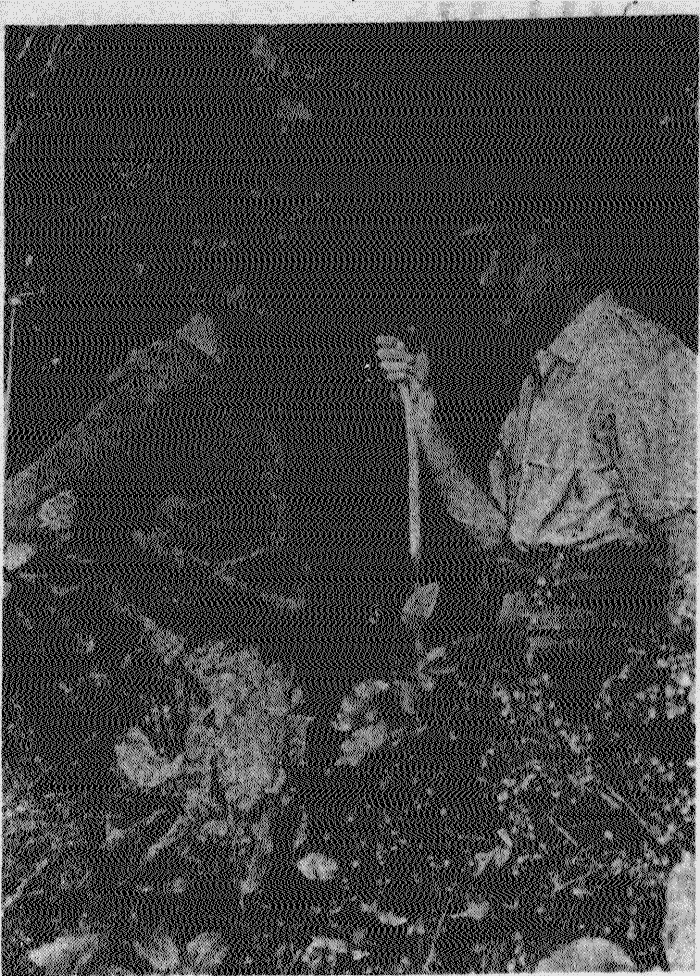|
|
Post by angelsonefive on Mar 29, 2010 18:00:35 GMT 12
Helicopters NZ were certainly around then, but if I recall correctly Mr Alexander had his own business, Alexander Helicopters Ltd.
|
|
fbarryf
Leading Aircraftman

Posts: 3
|
Post by fbarryf on Apr 20, 2010 12:24:06 GMT 12
Hi Guys,
I was flying Vampires on this exercise but unfortunately I have no photos to add to this site. Furthermore my memories of the whole affair are pretty vague apart from the overwhelming one that it was all good fun. The Vampire pilots from Ohakea were split into two groups and initially I was based at Ohakea and took on the role of attacker to those based at Rangataiki. On one occasion we were tasked to take a section of four aircraft to carry-out a dusk attack on the airfield and then position to Whenuapai. Early next morning we did the reverse by participating in a dawn attack before landing back at Ohakea and breakfast. As leader, on the way South I took the four to visit a former wings-course friend of mine farming in the Waikato. After a fly-by of my friend's farm we completed the exercise without incident, although I was forever reminded by my friend and his associates that cows being milked did not take too kindly to being visited by a section of low flying Vampires early in the morning.
Some days later, along with others, my role was reversed to being based at Rangataiki as a defender and in close support of the Army in the Taupo region. Operating from Rangataiki was quite a challenge with the amount of pumice dust that was always present, particularly on take-off. The Army Engineers were magnificent and fully employed restoring the airfield to acceptable levels as the Vampire’s low-slung jet exhaust managed to gouge out huge areas of pumice if not careful with throttle application. Full power on take-off from a standing start was a sight to behold and the solution was rolling starts with slow application of power. I seem to recall that all engine intakes despite our best efforts displayed a sand-blasted effect. That there were no serious incidents operating off the pumice strip was probably more to good fortune than anything else. As I say, two weeks of fun flying, no longer an option for modern pilots of the RNZAF.
Barry Flavall
|
|
|
|
Post by oj on Apr 21, 2010 22:27:45 GMT 12
Great to have aircrew input on Rangataiki Barry.
I do recall there was one flight incident when someone lost a turbine blade or two on take-off in a Mk5 and did a successful 180 turn-back and dead-stick landing.
Not sure who; might have been Goldsworthy?
OJ
|
|
|
|
Post by Freighter5910 on Feb 23, 2014 16:53:14 GMT 12
.
|
|
|
|
Post by Dave Homewood on Feb 23, 2014 19:45:52 GMT 12
Super photos, thanks for posting these!
It must have been very dusty with the props and the Goblin running!
|
|
zolteg
Flight Lieutenant
 
Posts: 82
|
Post by zolteg on Feb 24, 2014 22:59:22 GMT 12
My oh my. Didn't realise the history of this strip. I met an Andover there in 1986 when on an army Annual Camp as a U/T (well, someone had to put up the tents and dig the telephone lines into the ground....). I recall being astounded at the short landing, then the Andover backing up - had never seen that before.....
|
|
|
|
Post by oj on Dec 4, 2014 21:43:58 GMT 12
We had a bit of discussion on this exercise at the Hamilton RAeS Meeting last week.
Our guest speaker was ex-RNZAF pilot Ken Brooking who was at Reflex 2 flying Vampires.
Again, I appeal to you all to talk/email to your friends and relations about this significant exercise and try to find the old guy that has all the other photos!
|
|
|
|
Post by thomarse on Dec 5, 2014 15:58:35 GMT 12
I clearly recall an item on the TV news at the time, showing the billowing clouds of dust. How about TVNZ archives?
|
|
|
|
Post by starr on Dec 5, 2014 16:49:57 GMT 12
First time I have looked at this thread. SPANZ as far as I know put in the strip which was across the road from the old pub. It was on land owned by Poronui Station and sold to Stevensons some time later. Jack Humphries and I operated DC3 AZL off that strip in December 1962 and January 1963. The pumice dust was quite thick on takeoff. I will see if I still have any photos taken at that time. We stayed in the pub. Had quite a time there.
|
|
|
|
Post by oj on Dec 5, 2014 21:28:28 GMT 12
Great to see some more response to this. I can tell you that in the photo above labelled "A general view of the camp, at least the part visible from where the Freighter was parked." that those tents are some of the airfield operational tents. All the accommodation, messes, admin, medical etc (and the eight-man back-to-back army field crappers) were across the highway behind the tall pine trees.
it is really pleasing to see how interest has been rekindled. The exercise is gradually being recognised for its significance at last.
|
|
|
|
Post by Deleted on Dec 10, 2014 10:21:09 GMT 12
Fascinating stuff! Some brilliant photos - the colour slides are very atmospheric, but for me the winner is the Hastings coming in to land. Wonderful!
|
|
|
|
Post by angelsonefive on Dec 20, 2014 12:53:43 GMT 12
Some faint recollections of Reflex II ( or the Brigade Ex. as we usually referred to it ) from my point of view as a baggy pants private in the 2nd Battalion, NZ Regt, later 1 NZ Regt and 1 RNZIR :
The Hiller helicopter of Alexander Helicopters ( pilot Mike Alexander ) ferrying our CO Lt-Col. Robert M. Gurr around the battalion positions.
A Harvard making a very low level run at the control tower or watch office, whatever, at the airstrip then pulling up from ground level into a spectacular climbing roll, missing the structure by mere feet.
The Gov. General Sir Bernard Ferguson, resplendent in Brit. Army para smock and tamo'shanter cap addressing us during a break in the "battle". He was accompanied by his ADC, a British Army Captain, in similar attire. Bernard Ferguson had been one of Orde Wingate's Chindits in Burma. A brigade commander if I recall correctly.
The cold snap that brought snow to Helwan Camp just a day or two after our arrival from Burnham.
Flying back to Ch-Ch in a Bristol Freighter at the end of it all. A lovely day for flying and a great trip.
a15.
|
|
|
|
Post by oj on Oct 22, 2019 20:36:38 GMT 12
Hi Guys,
Here we are five years later and still hoping that perhaps some new readers or old guys cleaning out their archives might have found more photos to share with us.
Or perhaps further narrative from anyone else who was there.
|
|
|
|
Post by Dave Homewood on Sept 19, 2022 13:39:27 GMT 12
Birdie
Vampire fighter pilots have been painting their simulated "kills” beside their cockpits during the army exercises being carried out in the Rangitaiki area. The kills are recorded by a camera which take a shot each time the firing button is pressed. According to the drawings on one of the Vampires, its pilot had “killed” one and a half Vampires, a field gun, a truck, a jeep and a bird. The bird was a real kill. It was struck by the wing of the aircraft and evidence of the hit is still there—(P.A.)
PRESS, 11 OCTOBER 1963
|
|
|
|
Post by Dave Homewood on Oct 25, 2024 8:34:00 GMT 12
I am wondering, could these photos have been taken at Rangataiki during an Exercise Reflex?  2017-106.58 Image from the Frederick Barry Flavall personal collection. No. 75 Squadron Vampire NZ5774 ready to taxi away on a dirt airstrip. Unknown location.  2017-106.57 Image from the Frederick Barry Flavall personal collection. Two Harvards and three Vampires parked beside a dirt airstrip. Unknown location. NZ1015 and NZ1035 (sic) at left. |
|
|
|
Post by davidd on Oct 25, 2024 10:25:54 GMT 12
Harvard 37 with "dayglo" orange, no "Kiwi" roundels, that would have to be a possibility.
|
|
|
|
Post by Dave Homewood on Nov 17, 2024 20:33:53 GMT 12
The Press, 8 October 1963
Long Hours In Exercise
(New Zealand Press Association)
NEW PLYMOUTH, Oct. 7.
Air crews were on duty 24 hours without sleep and the staff at the joint headquarters near Ohakea were working regularly from 7 am. to 11 pm. manning key posts in the joint Army-Air Force exercise, Reflex Two, the Chief of Air Staff, Air ViceMarshal I. G. Morrison, said yesterday.
The exercise was easily the most valuable post-war training the Air Force had ever held, he said, after his visit to the air task force headquarters. It was giving valuable experience to the Army-Air Force joint agencies, as well as to flying units and technical and administrative staff, he said.
The Army force was tonight desperately fighting a defensive action against strong enemy troops from the northern country of “Redland.” The “allied force” with which the New Zealand troops are fighting are dependent on aircraft for most supplies.
The superior “Redland" air force has badly depleted the allied air power—by real and simulated attacks. While allied ground forces battle to hold back the “Redland” invaders, the battered remnant of the air force valiantly tries to knock out bridges and enemy airfields at Waverley, Hawera, New Plymouth, Hamilton, and Rotokawa to prevent interference with the supply aircraft.
Allied maintenance traffic on roads between Mangaweka and Ohakune was attacked by enemy aircraft this morning and suffered some loss. The Mohaka bridge was destroyed by an enemy guerrilla force. The simulated enemy attempting to cross the Wanganui river between the coast and Makirikiri was thrown back, but the border was believed to have been penetrated between Makirikiri and Pipiriki.
Further penetration was reported past of Lake Taupo and further south allied troops have been driven back five miles from the border and are now entrenched on high ground south of Raetihi. The Pokaka and Atiamuri bridges were destroyed and enemy guerrillas demolished a number of small bridges and culverts along the lines of the main attacks in attempts to cut off small groups of allied forces.
A simulated battle group near Mohaka is cut off behind the destroyed bridge and is now completely dependent on air supply for food and ammunition. The first day of the attack has ended with the allies moving back slightly to force the invaders to over-extend their lines of communication, making them more vulnerable to a counter-attack by the New Zealanders and their allies.
|
|
|
|
Post by Dave Homewood on Nov 17, 2024 20:36:31 GMT 12
The Press, 8 October 1963
LEAKING PETROL
Plane Crew In Danger
(N.Z. Press Association) NEW PLYMOUTH. Oct. 7.
Leaking petrol cans and an 18-knot cross-wind endangered the lives of men aboard a Bristol freighter at Rangitaiki on Saturday. When the aircraft was due to land at the Exercise Reflex Two airstrip, firemen were battling a grass fire near the camp. During the flight to the strip from Ohakea, atmospheric pressure at 8000 feet caused some of the 192 jerry cans of petrol on board to leak. With fuel sloshing around the deck and the strong crosswind, some anxious moments were experienced by the crew. The mobile fire tender usually on duty at the strip was away tending the grass fire. After five circuits of the area, the freighter landed safely.
|
|
|
|
Post by Dave Homewood on Nov 17, 2024 20:41:32 GMT 12
The Press, 11 October 1963
Hired Helicopter Flies Out Injured Soldier
(New Zealand Preu Association)
PALMERSTON NORTH, October 10. The combined Air-Army exercise —" Reflex Two"— was a “very realistic one." the Minister of Defence (Mr Eyre) said today. He had visited the centre of the exercise activities at Rangitaiki and inspected the joint exercise headquarters at the R.N.Z.A.F. station at Ohakea. At the headquarters Mr Eyre was briefed on the running of the exercise by Brigadier G. P Cade and Air Commodore T. F. Gill. With Mr Eyre was the newly-appointed Secretary of Defence (Mr J. K Hunn) and the Chief of Air Staff (Air Vice Marshall I. G. Morrison).
Mr Eyre said the exercise was giving the soldiers and air personnel the opportunity to work under war conditions, with all the stresses and strain. “It has shown up some excellent planning. I have seen the forces' ability to swing quickly into active service conditions."
The rugged country in which the exercise was being carried out could not be more testing, he said. The terrain was as hard as any the troops would be likely to meet.
Speaking on “casualties" suffered throughout the exercise—some of which were simulated—Mr Eyre said he could see the benefit of helicopters which the Government was acquiring shortly. During the exercise a helicopter was hired for a short time, Mr Eyre said. It proved its usefulness.
A soldier, who was suffering from suspected broken ribs, was moved out of rugged country by helicopter in 20 minutes. Had he been brought out by stretcher it would have taken nearer eight hours, he said.
“This is not a mere paper battle. Long hours of work have been put into the exercise.” said Mr Eyre. “Such an exercise not only showed the ability of the services to fulfill their role, but also, under arduous conditions, brought out any points which might need strengthening or improving.”
|
|
|
|
Post by Dave Homewood on Nov 17, 2024 20:44:04 GMT 12
GENERAL IN “COMBAT” AREA Soldiers of the 2nd Battalion, New Zealand Regiment, on their final field-training exercise before going to Malaya next month, were visited briefly by Major-General L. W. Thornton, Chief of the General Staff, during the opening phase of the combined Army-Air Force exercise, “Reflex Two.” General Thornton, who travelled by air to the forward airfield at Rangitaiki, and from there by helicopter, utility vehicle, and on foot to visit units of the 2nd Infantry Brigade Group, is shown talking to Private R. J. Stanaway, of Christchurch, beside a camouflaged tent The Press, 12 October 1963  |
|



